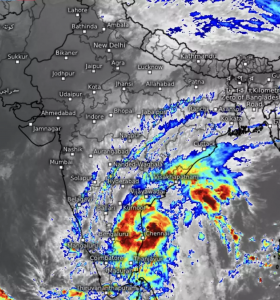ForumIAS announcing GS Foundation Program for UPSC CSE 2025-26 from 27th May. Click Here for more information.
Source: This post on Cyclone Michaung has been created based on the article “Shared blame” published in “The Hindu” on 6th December 2023.
UPSC Syllabus Topic: GS Paper 3 Disaster and disaster management.
News: The article discusses the reasons other than the natural calamity which led to the recent crisis in Chennai due to Cyclone Michaung.
Detailed articles on developments related to Cyclones can be read here.
Late on December 3, heavy rains hit Chennai due to Cyclone Michaung. Most areas recorded more than 120 mm of rain, with a few even recording more than 250 mm (a very huge volume of rain in a single day).
Cyclone Michaung:
1 It was formed over the Bay of Bengal on November 29, 2023. It moved westward and intensified into a severe cyclonic storm.
2 The storm made landfall near Bapatla, Andhra Pradesh, on December 5, with winds of up to 110 kilometers per hour. It caused widespread damage in Andhra Pradesh and Tamil Nadu.
3 The storm caused heavy rains, flooding, and power outages. At least 12 people were killed and around 9,450 people were evacuated.
4 Named by Myanmar, Michaung means ‘strength and resilience’.
Cyclone Michaung. Source: The Hindu BusinessLine
What factors apart from the natural calamity worsened the situation?
- Issues with the Power Infrastructure: Inadequate investment in maintenance and repair meant that the power had to be cut off in the city as a precaution to prevent loose electric cables from electrocuting pedestrians.
- Unplanned construction: This includes defiance of zoning (construction based on consideration of flood situations). This led to water stagnation on almost all roads.
- Public indiscipline: This includes littering, leading to storm water drains choking with plastic trash.
- Climate Change: Climate change is contributing to the intensification and increased frequency of cyclones due to rising sea surface temperatures and altered atmospheric conditions.
What should be done?
In order to deal with such situations, the following can be implemented:
- Power Infrastructure Issues: Increased allocation of funds for maintenance. Apart from this, measures like using waterproof materials, or relocating vulnerable infrastructure away from flood-prone areas can be done.
- Unplanned Construction: Strictly enforcing zoning laws and regulations. Measures like better drainage systems or green infrastructure to absorb water should be the way forward.
- Public Indiscipline: Public Awareness Campaigns and Community Engagement Initiatives should be implemented.
Question for practice:
Dealing with cyclones requires a holistic multi-sectoral approach rather than working in silos. Discuss in the context of the havoc caused by Cyclone Michaung in Chennai.





